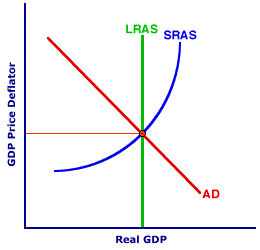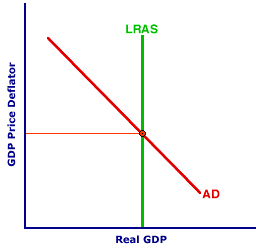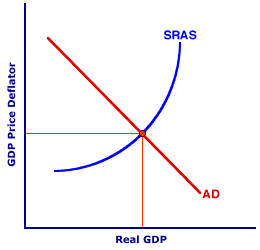
|
|
ARC ELASTICITY: The average elasticity for discrete changes in two variables, A and B. The distinguishing characteristic of arc elasticity is that percentage changes are calculated based on the average of the initial and ending values of each variable, rather than only initial values. Arc elasticity is generally calculated using the midpoint formula. Arc elasticity should be compared with point elasticity. For infinitesimally small changes in variables A and B, arc elasticity is the same as point elasticity.
Visit the GLOSS*arama
|
|


|

|
                           AGGREGATE MARKET: An economic model relating the price level and real production that is used to analyze business cycles, gross production, unemployment, inflation, stabilization policies, and related macroeconomic phenomena. The aggregate market, inspired by the standard market model, but adapted to the macroeconomy, captures the interaction between aggregate demand (the buyers) and short-run and long-run aggregate supply (the sellers). Also known by the names AS-AD model or income-price model, the aggregate market is THE cornerstone model of macroeconomic analysis. The aggregate market model combines the aggregate demand of the four macroeconomic sectors--household, business, government, and foreign--with the aggregate supply of real production (long run and short run). This model emerged onto the theoretical scene in the 1970s, replacing the Keynesian economic model that dominated macroeconomics from the 1940s to the 1970s. In its present form, it provides a general model of the economy that can be used to explain and understand periods of both contractionary unemployment and expansionary inflation. It incorporates the importance of aggregate demand, emphasized by Keynesian economics, as well as aggregate supply, emphasized by classical economics.The extended name for this model is the aggregate product market, to emphasize that it reflects the exchange of gross domestic product in the macroeconomic product markets. However, the two other basic macroeconomic markets--financial markets and resource markets--play key roles behind the scenes and close to the surface of the aggregate market. The Basic Graphical Model| The Aggregate Market |  |
The exhibit to the right illustrates the basic components of the aggregate market. The vertical axis measures the price level (GDP price deflator) and the horizontal axis measures real production (real GDP). The negatively-sloped curve, labeled AD, is the aggregate demand curve; the positively-sloped curve, labeled SRAS, is the short-run aggregate supply curve; and the vertical curve, labeled LRAS, is the long-run aggregate supply curve.The analytical value of this model results from identifying the equilibrium price level and real production. Then perhaps more informative, the model is used analyze shifts of these three curves and how the shifts affect the equilibrium price level and real production. In so doing implications about unemployment, inflation, income, and other macroeconomic activity can be obtained. Inspired by the MarketLike the standard market model used in microeconomics, the aggregate market captures price and quantity interactions between buyers and sellers. There are, however, two key differences.- One key difference is the measurement units. The "price" in the aggregate market is actually the price level, usually measured by the GDP price deflator, and the "quantity" is real production, usually measured by real gross domestic product (real GDP).
- Another key difference is the supply-side of the model. The supply-side of the aggregate market is divided into short-run aggregate supply and long-run aggregate supply. The difference between these two is based on price flexibility, or the time required for prices to adjust to equilibrium levels. The long-run aggregate supply presumes that ALL prices are flexible, while the short-run aggregate supply presumes that some prices, especially resource prices, are inflexible.
Going Long and Short| The Long-Run Aggregate Market |  | The Short-Run Aggregate Market |  |
The separation of the supply-side of the aggregate market into long-run and short-run aggregate supply gives rise to two aggregate market "submodels," the long-run aggregate market and the short-run aggregate market.- Long-Run Aggregate Market: The long-run aggregate market, presented in the top panel of the exhibit to the right, isolates the interaction between aggregate demand and long-run aggregate supply. The key assumption of this model is that ALL prices, especially resource prices, are flexible. This gives rise to the vertical long-run aggregate supply curve. The primary result of this model is that the economy achieves long-run equilibrium at full-employment real production.
- Short-Run Aggregate Market: The short-run aggregate market, presented in the bottom panel of the exhibit to the right, isolates the interaction between aggregate demand and short-run aggregate supply. The key assumption of this model is that some prices, especially resource prices, are inflexible. This generates the positively-sloped short-run aggregate supply curve. The primary result of this model is that the economy can achieve short-run equilibrium at real production levels that are greater or less than full employment.
Whether long-run or short-run, full-employment takes center stage in the aggregate market. In the long-run aggregate market, real production achieves full employment regardless of changes in aggregate demand or the price level. In the short-run aggregate market, however, equilibrium can occur at production levels greater or less than full employment.In particular, an inflationary gap results if short-run equilibrium production exceeds full employment and a recessionary gap occurs if production falls short of full employment. These output gaps not only illustrate the essence of business-cycle instability, but also suggest the role stabilization policies can play in achieving full employment. Three Markets In OneTo be technically precise, the aggregate market is the aggregate "product" market. Including this extra term highlights the fact that the aggregate market is the aggregation of the economy's product markets, markets that exchange final goods and services, or gross domestic product. However, two other aggregated macroeconomic markets, financial and resource, are also working behind the scenes of the aggregate market.- Financial markets provide the liquidity (money and loans) that buyers use to purchase the production.
- Resource markets provide the inputs (labor, capital, land, and entrepreneurship) that producers need to supply the production.
These three markets give rise to two notions of equilibrium for the aggregate market--long-run equilibrium and short-run equilibrium.- Long-run equilibrium is based on equilibrium in ALL three aggregate markets, product, financial, and resource.
- Short-run equilibrium, in contrast, is based on equilibrium in the product and financial markets, but disequilibrium in the resource markets.
The difference between long-run and short-run equilibrium takes center stage in most of the analysis, policy, and controversy of macroeconomics. The existence and persistence of short-run equilibrium gives rise to recessionary and inflationary gaps, with the associated problems of unemployment and inflation, and suggests a key role for government stabilization policies. Long-run equilibrium, in contrast, implies a healthy, prosperous, problem free economy that needs no government intervention.

Recommended Citation:AGGREGATE MARKET, AmosWEB Encyclonomic WEB*pedia, http://www.AmosWEB.com, AmosWEB LLC, 2000-2025. [Accessed: July 18, 2025].
Check Out These Related Terms... | | | | | | |
Or For A Little Background... | | | | | | | | | | | | | |
And For Further Study... | | | | | | | | | | | |
Search Again?
Back to the WEB*pedia
|



|

|
|
The wealthy industrialist, Andrew Carnegie, was once removed from a London tram because he lacked the money needed for the fare.
|

|
|
"A winner is someone who recognizes his God-given talents, works his tail off to develop them into skills, and uses those skills to accomplish his goals. " -- Larry Bird, basketball player
|

|
Y
Income, Nominal Gross National Product
|

|
|
Tell us what you think about AmosWEB. Like what you see? Have suggestions for improvements? Let us know. Click the User Feedback link.
User Feedback
|


|


